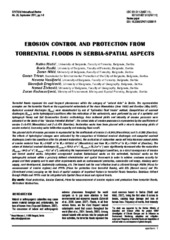Приказ основних података о документу
Erosion Control and Protection from Torrential Floods in Serbia-Spatial Aspect
| dc.creator | Ristic, Ratko | |
| dc.creator | Radic, Boris | |
| dc.creator | Nikic, Zoran | |
| dc.creator | Trivan, Goran | |
| dc.creator | Vasiljevic, Nevena | |
| dc.creator | Dragicevic, Slavoljub | |
| dc.creator | Zivkovic, Nenad | |
| dc.creator | Radosavljevic, Zoran | |
| dc.date.accessioned | 2023-11-26T18:27:07Z | |
| dc.date.available | 2023-11-26T18:27:07Z | |
| dc.date.issued | 2011 | |
| dc.identifier.issn | 1450-569X | |
| dc.identifier.uri | http://rimsi.imsi.bg.ac.rs/handle/123456789/2357 | |
| dc.description.abstract | Torrential floods represent the most frequent phenomenon within the category of “natural risks” in Serbia. The representative examples are the torrential floods on the experimental watersheds of the rivers Manastirica (June 1996) and Kamišna (May 2007). Hystorical maximal discharges (Qmaxh) were reconstructed by use of ″hydraulics flood traces″ method. Computations of maximal discharges (Qmaxc), under hydrological conditions after the restoration of the watersheds, were performed by use of a synthetic unit hydrograph theory and Soil Conservation Service methodology. Area sediment yields and intensity of erosion processes were estimated on the basis of the “Erosion Potential Method”. The actual state of erosion processes is represented by the coefficients of erosion Z=0.475 (Manastirica) and Z=0.470 (Kamišna). Restoration works have been planned with a view to decreasing yields of erosive material, increasing water infiltration capacity and reducing flood runoff. The planned state of erosion processes is represented by the coefficients of erosion Z=0.343 (Manastirica) and Z=0.385 (Kamišna). The effects of hydrological changes were estimated by the comparison of historical maximal discharges and computed maximal discharges (under the conditions after the planned restoration). The realisation of restoration works will help decrease annual yields of erosive material from Wа=24357 m3 to Wа=16198.0 m3 (Manastirica) and from Wа=19974 m3 to Wа=14434 m3 (Kamišna). The values of historical maximal discharges (QmaxhMan=154.9 m3•s-1; QmaxhKam=76.3 m3•s-1) were significantly decreased after the restoration (QmaxcMan=84.5 m3 •s-1; QmaxcKam=43.7 m3•s-1), indicating the improvement of hydrological conditions, as a direct consequence of erosion and torrent control works. Integrated management involves biotechnical works on the watershed, technical works on the hydrographic network within a precisely defined administrative and spatial framework in order to achieve maximum security for people and their property and to meet other requirements such as: environmental protection, sustainable soil usage, drinking water supply, rural development, biodiversity sustaining, etc. The lowest and the most effective level is attained through PAERs (Plans for announcement of erosive regions) and PPTFs (Plans for protection from torrential floods), with HZs (Hazard zones) and TAs (Threatened areas) mapping on the basis of spatial analysis of important factors in torrential floods formation. Solutions defined through PAERs and PPTFs must be integrated into Spatial Plans at local and regional levels. | |
| dc.language.iso | en | sr |
| dc.publisher | Belgrade : Institute of Architecture and Urban Planning of Serbia | sr |
| dc.rights | openAccess | sr |
| dc.source | Spatium | sr |
| dc.subject | Flood protection / erosion control / plans for announcement of erosive regions and protection from torrential floods / watershed restoration | |
| dc.title | Erosion Control and Protection from Torrential Floods in Serbia-Spatial Aspect | sr |
| dc.type | article | sr |
| dc.rights.license | ARR | sr |
| dc.identifier.doi | 10.2298/SPAT1125001R | |
| dc.identifier.fulltext | http://rimsi.imsi.bg.ac.rs/bitstream/id/8414/bitstream_8414.pdf | |
| dc.type.version | publishedVersion | sr |

